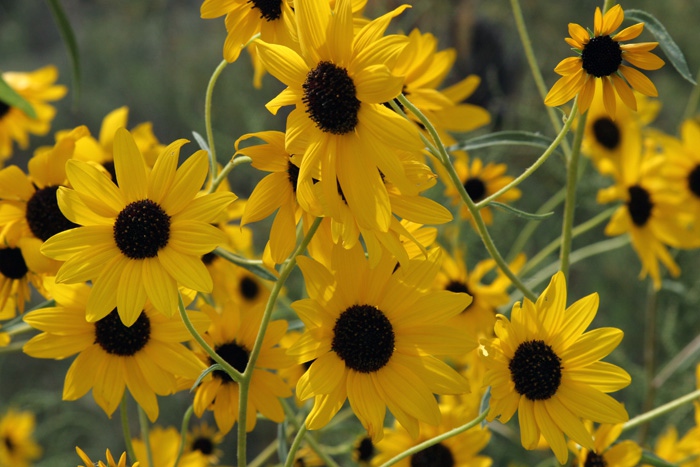Pecos Sunflower
In 1999, the Pecos sunflower was federally listed as threatened by the U.S. Fish and Wildlife Service. It also is listed as endangered in New Mexico under 19.21.2.2 NMAC, ENDANGERED PLANT SPECIES LIST AND COLLECTION PERMITS.
-
Scientific Name: Helianthus paradoxus
-
Species Abbreviation: PESU
-
Status:
Federally Threatened Species;
New Mexico State Endangered Species
- Documents
-
View documents from the Program Library.
See All documents

Photo Credit: U.S. Fish and Wildlife Service
- Texas Parks and Wildlife Department Pecos Sunflower
- U.S. Fish and Wildlife Service Environmental Conservation Online System
- U.S. Fish and Wildlife Service Pecos Sunflower
- U.S. Fish and Wildlife Service Pecos Sunflower Final Recovery Plan
- New Mexico Rare Plants Pecos Sunflower
- NatureServe Explorer Pecos Sunflower
Description
The Pecos sunflower is an herbaceous annual plant that grows 3-9 feet tall and is branched at the top. The lower part of the plant's stem has leaves that are opposite one another, while the leaves become alternate higher up the stem. The stem and leaves have a few short, stiff hairs but are mostly hairless. The plant's leaves are a narrow teardrop shape and usually grow to between 2.75-6 inches long. The leaves have three prominent and roughly parallel veins that run from the base of its leaves towards their tips. The flower heads of the Pecos sunflower have bright yellow rays (petals) with dark purplish brown disc flowers (centers) and are 2-2.75 inches in diameter (including the rays). There are 3-5 flower heads on each of the many branches. Although the Pecos sunflower can resemble the common sunflower (Helianthus annuus), it can be distinguished by its narrower leaves, fewer hairs, smaller flower heads, and narrower bracts (phyllaries) around the base of the flower heads.
This wetland plant grows in seasonal to permanently wet soils in areas where desert springs and seeps form wet meadows called cienagas. High evaporation rates in cienagas create saline conditions where only salt-tolerant species such as the Pecos sunflower can thrive. However, germination is most successful when high water tables temporarily reduce salinity near the soil's surface. The Pecos sunflower requires open areas not shaded by taller vegetation. Although the plant has a highly disconnected distribution, little variation in phenotype among populations has been observed. One known exception is a mutation within the Bitter Lakes population in southeastern New Mexico. Within this population, there are small patches of sunflowers that produce bright red rays with yellow tips.
The Pecos sunflower blooms from August to November. It re-establishes new seedlings each year and is dependent on seeds produced during the previous year. The plants often grow in dense patches of dozens up to thousands of individuals.
Distribution
The historical distribution of the Pecos sunflower included New Mexico and Texas; however precise locations of historical populations are not fully documented. The plant now has four core populations in Texas and New Mexico. The five counties in New Mexico with Pecos sunflower occurrences are Chaves, Guadalupe, Socorro, Cibola, and Valencia. Sites where the Pecos sunflower occurs are often less than two hectares in size, with some being only a small fraction of a hectare.
Recovery Efforts
The Pecos sunflower is currently protected in New Mexico and Texas. The primary threats to the Pecos sunflower and its required wetland habitats - e.g., spring seeps and desert ciénagas - are filling, groundwater pumping, aquifer depletion, surface water diversion, and agricultural activities. Other threats include competition from non-native plant species, livestock overgrazing, mowing, and highway maintenance. Current strategies for species recovery include mitigating incompatible land use, habitat loss or degradation, and significant and permanent drawdowns of groundwater. In 2020, the MRGESCP included recovery of the Pecos sunflower in its long-term goals.
